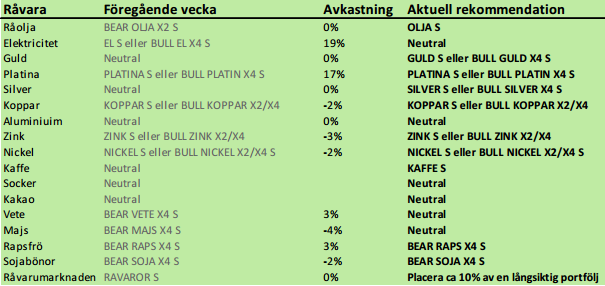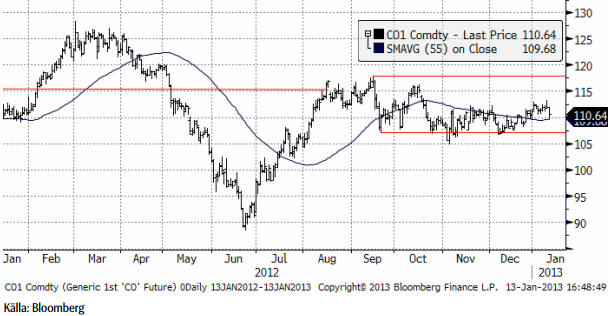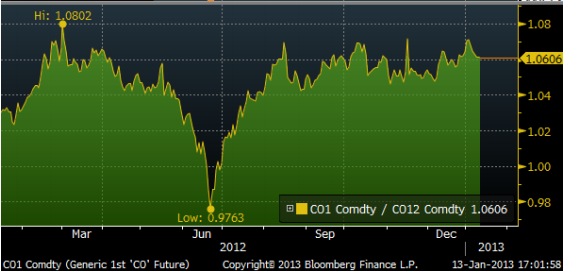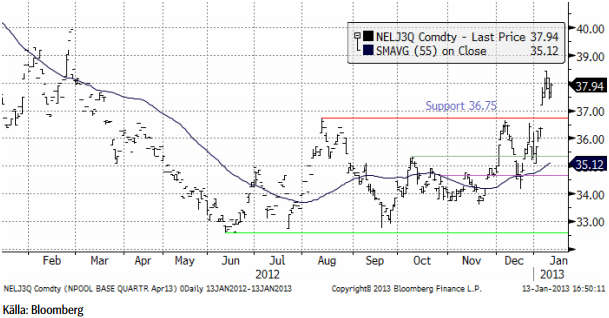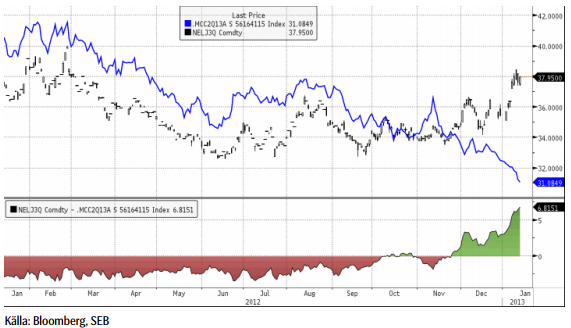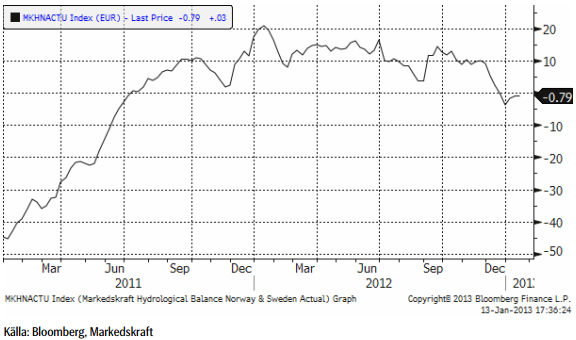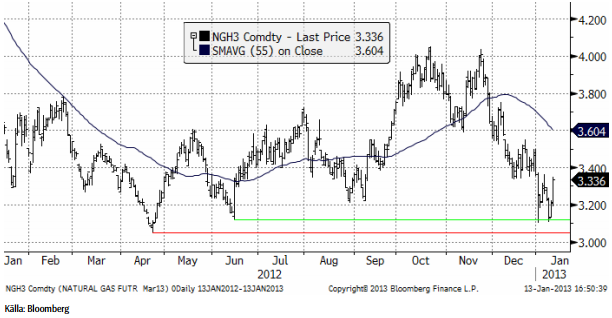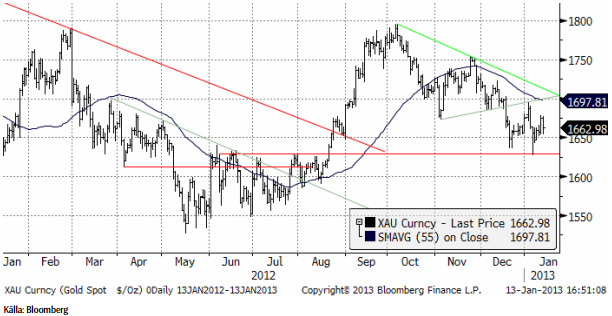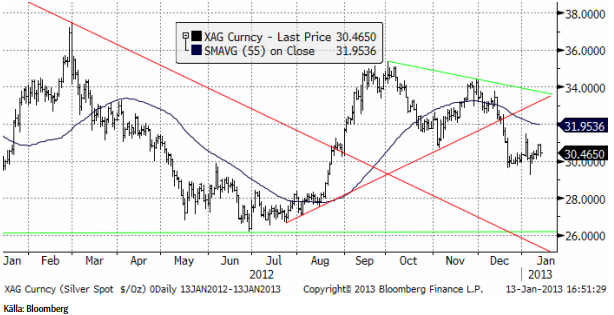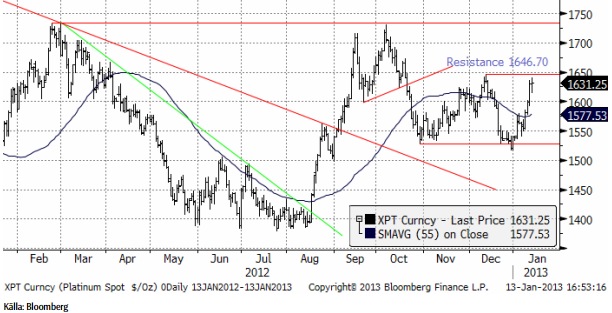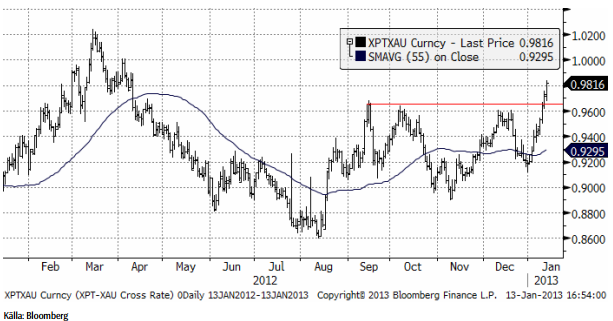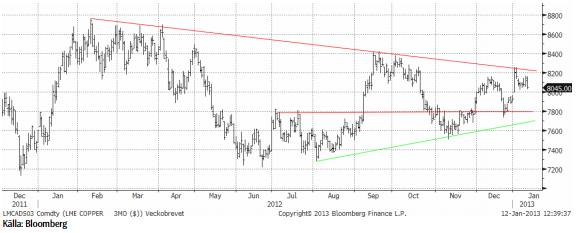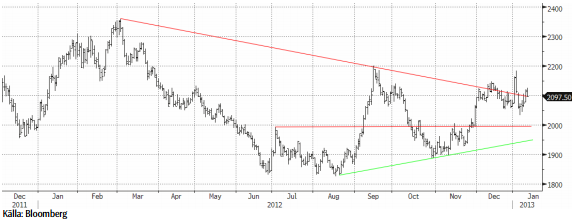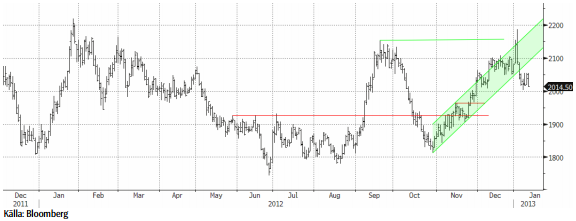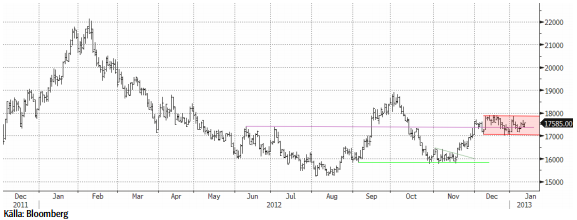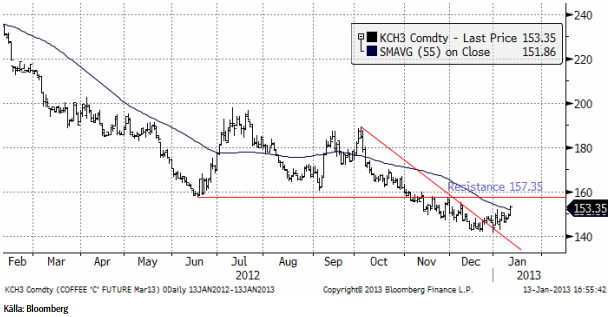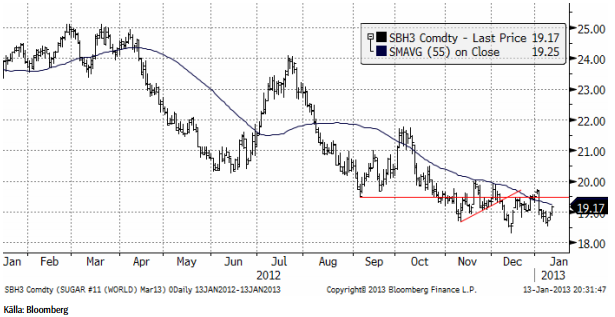Analys
SEB – Råvarukommentarer, 14 januari 2013
Sammanfattning av rekommendationer
Inledning
Råvaruindex var oförändrat i veckan som gick. Till vinnarna hörde platina, el, majs och kaffe. De som föll mest var utsläppsrätter för CO2 och kol (som båda används för att producera el) och zink. På grund av diskrepansen mellan elpris och kostnaden för att producera el, går vi över till neutral rekommendation på el. I fredags kväll publicerade det amerikanska jordbruksdepartementet (USDA) också sina månatliga estimat på jordbruksprodukter, samt höstsådd av vete och lager per 1 december. Efter att ha analyserat den statistiken ändrar vi också säljrekommendationerna för majs och vete till neutral rekommendation. Socker och i synnerhet kaffe ser ut att bilda en botten efter en lång tid av fallande pristrend. För kaffe går vi över till en köprekommendation av KAFFE S, men avvaktar med socker i neutralt läge.
Råolja – Brent
Priset på råolja föll kraftigt i fredags, vilket vi ser som en några dagar försenad nedgång. På den positiva sidan meddelade Saudiarabien att de sänker sin produktion med 4.9% till 9.025 miljoner fat om dagen från december för att undvika ”överproduktion” under det första halvåret i år. Det visar en påtaglig vilja att hålla priset stabilt på den här nivån.
Oljemarknaden ter sig väldigt tråkig, eftersom det är näst intill inga kursrörelser. Däremot ger den en ganska attraktiv avkastning för den som bara vill äga OLJA S. I diagrammet nedan ser vi prisskillnaden mellan det 12 månader långa terminskontraktet och det kortaste (”spotkontraktet”). Den visar att den som på årsbasis äger oljeterminer tjänar 6% utöver spotprisförändringen. Det är en ganska god avkastning, även om spotpriset inte rör sig.
Den senaste veckan har skillnaden mellan 12-månaders terminskontrakt och spotkontraktet fallit. Det innebär att marknaden tycker att det blivit mindre brist på spotmarknaden, vilket rimmar illa med att Saudiarabien har strypt sin produktion.
Nedan ser vi den veckovisa lagerstatistiken från USA. Den visade på en ökning av råoljelagren i linje med förväntningarna, men en ökning av bensin och destillatlagren som var större än väntat.
Sammanfattningsvis, råolja har blivit en lite tråkig marknad, men den erbjuder en stabil extraintjäning, utöver räntan (som i och för sig just nu är noll i dollar), som är attraktiv, samtidigt som man äger en råvara som har en chans att stiga om värre oro uppstår i t ex Mellanöstern. Detta brukar vara negativt för aktiemarknaden, så olja har alltid varit en bra råvara att vara investerad i. Vi rekommenderar alltså köp av OLJA S.
Elektricitet
Elpriset, som ”gappade” upp över motståndslinjen (nu stödlinjen) på 36.75 euro per MWh, har stabiliserats kring 38 euro. Det vanliga är att ”gap” fylls. Det skulle innebära att vi får se en rekyl ner mot stödlinjen. Fundamenta talar också för lägre pris. Vi rekommenderar alltså att man kortsiktigt tar hem vinster på långa positioner.
Nedan ser vi terminspriset för andra kvartalet och marginalkostnaden för att producera elektricitet med kol, i euro per MWh. På lång sikt är det marginalkostnaden för kolkraft som styr elpriset i Sverige. Vatten- och kärnkraft räcker inte till och då är det kol som styr vid den konsumtion vi ligger på idag (och konsumtionen har varit ungefär på konstant nivå de senaste åren).
Det är naturligtvis orimligt att priset ska stiga samtidigt som kostnaden faller. Anledningen till avvikelsen kan möjligtvis finns i förändringar i den hydrologiska balansen.
Markedskraft publicerar statistik på den hydrologiska balansen för Norge och Sverige. Den anges i TWh kraft som finns lagrat i vatten som kan passera ett vattenkraftverk. I diagrammet nedan visas hur mycket mer / mindre som finns i förhållande till vad som är normalt. Och med normalt avses genomsnittet för respektive dag på året mellan 1962 och 2006. Vi ser i diagrammet att den hydrologiska balansen gått från ett överskott på ca 10 TWh till ett litet underskott. Detta har skett på bara lite drygt en månad.
December och januari är de månader när vattenkraftverken producerar mest elektricitet, men vi kan se skillnaden på utvecklingen i år jämfört med årsskiftet mellan år 2011 och 2012, när den hydrologiska balansen ökade.
Sammantaget tror vi ändå att elpriset rusat iväg lite för fort på tekniska faktorer och att fundamenta kommer att dra ner priset igen, åtminstone på kort sikt. Vi rekommenderar därför att man går ur långa positioner.
Naturgas
Naturgasterminen på NYMEX (mars 2013) steg med 2.6% i fredags upp från stödnivåerna vi skrev om i förra veckobrevet. Tekniskt ser marknaden ut att vilja rekylera uppåt efter att ha varit i fallande trend sedan oktober-november. Prisuppgången var en reaktion på att USA:s Energy Information Administration (EIA) rapporterade den största lagerminskningen på veckobasis sedan februari för två år sedan. Lagren minskade med 201 miljarder kubikfot, betydligt mer än väntade 191 miljarder kubikfot.
Men ovanligt varmt väder är på väg in över USA och prognosen är att det ska hänga sig kvar i veckan. Temperaturen spelar stor roll, eftersom 50% av amerikanska hem använder gas för uppvärmning. I fredags publicerade Bloomberg en sammanställning av 14 tillfrågade gasmarknadsanalytiker. Den visade att 10 av dem (71%) förutspådde lägre priser på naturgas i veckan som kommer, pga det varmare vädret. Å andra sidan var visserligen temperaturen ovanligt hög (den högsta de senaste fem åren) i Chicago i fredags, men hade i går (söndags) fallit abrupt ner till för årstiden normala nivåer igen.
Nedan ser vi ett kursdiagram på mars-kontraktet på NYMEX-börsen. Det är detta kontrakt som just nu är underliggande i BULL NATGAS X4 S och BEAR NATGAS X4 S. Vi ser att det finns starka stöd precis under dagens kursnivå. Det ger i sig ingen anledning att rekommendera köp, men man bör i vart fall inte vara köpt BEAR NATGAS X4 S, så länge stödnivåerna håller
Guld och Silver
Guldpriset har fortsatt att handlas i fallande trend. Det tekniska stödet på strax över 1625 höll när det testades tidigare i år. Det talas i USA om behov av ännu mer monetär stimulans (ökning av penningmängden). Det tynger dollarn och stärker därmed guldpriset (som noteras i dollar).
Nedan ser vi kursdiagrammet för silver i dollar per troy ounce. Situationen är snarlik den för guld. Vi tror att de senaste veckornas rekyl uppåt är just det, en rekyl. Trenden nedåt pekar mot 28 dollar per troy uns.
Platina
Platina, vår favorit bland de tre ädelmetallerna, har gått upp rejält i veckan som gick. Marknaden testar nu en kortsiktig motståndsnivå på 1646.70. Bryts den, är det fritt upp till 1730 dollar.
Nedan ser vi priset på platina i termer av guld, eller ”växelkursen” mellan XPT och XAU, valutakoderna för de två ädelmetallerna. Vi ser att platina har passerat en viss motståndsnivå i relationen. Platina har nu mindre än 2% kvar till att handlas på par till guld. Platina har historiskt varit dyrare än guld. Det har varit det ”normala” och situationen kan vara på väg att ”normaliseras” igen.
Vi tror alltså på att priset på platina ska gå upp och på att platina ska ge bättre avkastning än guld och silver. Vi rekommenderar köp av PLATINA S eller BULL PLATIN X2/X4 S för den som vill ha högre utväxling.
Basmetaller
Efter årets starka inledning med uppgångar på 3-4 % under den första handelsdagen har optimismen avtagit. Priserna har successivt fallit tillbaka, men är ändå upp på året efter 1,5 veckas handel mellan 1 och 3 %. Undantaget är zink som föll tillbaka relativt kraftigt under den senare delen av den gångna veckan. Zink är nu ned 3 % under årets inledning. Till detta finns en möjlig förklaring (som delas av andra aktörer): omviktning av två av de största råvaruindexen under perioden 8-15 januari. Uppgifterna varierar något men klart står att de behövt sälja mycket aluminium och zink, det ryktas om 13,000 LME-poster vardera under perioden. Inte så mycket likviditetsmässing för aluminium, men desto svårare för zink att ta emot.
Kinesisk statistik kommer in fortsatt starkt. I veckan var det handelsbalansen som inger förtroende med ökad export och import. Det senare avspeglas i fortsatt bra efterfrågan på metaller, framför allt koppar och järnmalm. Samtidigt ökade inflationen lite mer än väntat (2,5 %) vilket påverkade marknaden lite negativt under fredagen. Oro för amerikanska budgetförhandlingar kommer prägla marknaden de närmsta veckorna, men viktigast är ändå signalerna från Kina. Det blir nog lite avvaktande inför det kinesiska nyåret (med början 10 feb) och utvecklingen i början av Ormens år. Vi kvarstår med vår bedömning om fortsatta stimulanser vilket ger stöd till markanden och reducerar risken på nedsidan. Positiva överraskningar från övriga världen kommer kunna ge styrka till de basmetaller som enligt vår mening har störst potential på uppsidan ur ett fundamentalt perspektiv (nickel och zink).
Koppar
Kinas handelssiffror uppfattades som positiva, framför allt då exporten ökade (bra efterfrågan i omvärlden). Kopparimporten var dock något av en besvikelse. Den föll från 365 tton i november till 341 tton i december. Toppmånaderna brukar ligga kring 450 tton. Det är fortsatt höga siffror och trenden är ökande, kanske inte i den takt som kan förväntas den här tiden på året.
Den tekniska bilden är relativt neutral för tillfället. Om LME-noteringen (3 månaders) kommer ned mot $7800 är det ett köp. Alternativet är att avvakta ett brott på uppsidan, vilket skulle vara definitivt över $8400.
Aluminium
En positiv kvartalsrapport från en väldens största aluminiumproducenter, amerikanska Alcoa, påverkade alla finansiella marknaden under veckans inledning. Resultatet kom in som väntat, men det var framför allt framtidsutsikterna som blev tongivande. Bolaget tror på en stark efterfrågan som väntas växa klart över trend på 7 %, och föga förvånade, främst drivet från Kina. Vi har nämnt tidigare att aluminium tar marknadsandelar från andra material och har därmed väldigt ljusa utsikter.
”Problemet” är utbudet som är överhängande. Alcoa tror på ett fortsatt överskott som tar tid att beta av. Den starka efterfrågan begränsar nedsidan, samtidigt som utbudet har motsvarande effekt på uppsidan. Terminsmarknaden har lugnat ned sig efter turbulensen i december då skillnaden mellan spotpriser och terminspriser var negativ (backwardation).
Tekniskt sett ligger priset och balanserar på trendlinjen, men tenderar att vilja bryta uppåt. Vi är fortsatt lite avvaktande men utesluter inte nya test upp mot motståndsnivån $2200.
Zink
Som vi nämnde i ingressen led zinken av veckans omviktning av råvaruindexen. Stora volymer skulle säljas (enligt rykten ca 13 000 LME-kontrakt, vilket är ganska mycket för zink). Detta är av tillfällig karaktär och således bör trycket av den orsaken minska i veckan.
Som vi skrivit tidigare är de största användningsområdena för zink bygg- och transportindustrin. Två områden som nu gynnas av en mer positivt syn på tillväxten i Kina och USA. Zink ligger väl placerad i det scenariot. De kommande årens begränsningar av utbudet talar också för en starkare zinkmarknad. Hotet är, som vi också nämnt tidigare, kortsiktigt överskott p.g.a. ökad gruvproduktion i Kina. Enligt bedömare avtar tillväxten nu av det kinesiska utbudet. Zinkpriset är fortfarande lågt ur ett produktionskostnadsperspektiv och lönsamheten är svag i smältverksledet. Överskottet har också byggt stora lager som måste betas av. Ett troligt scenario är samma utveckling som för aluminium, d.v.s. att lagret knyts upp i finansieringsupplägg (se tidigare beskrivningar kring aluminiummarknaden) som kommer att undanhålla material från konsumenter, vilket framför allt gynnar de fysiska premierna, men också sannolikt zinkpriset. Omsvängningen av stämningsläget gör att vi nu bedömer att marknaden kommer diskontera starkare fundamental balans, vilket ofta innebär att investerare köper i ”förtid”.
Veckan före jul rekommenderade vi att ta vinst kring motståndet vid 2150. Priset bröt ur kanalen och tillfälligtvis upp till ca2190 under årets första handelsdag. Vinsthemtagningarna har varit kraftiga och i kombination med omviktningen av råvaruindex (se ovan) blev pressen stor. Ur ett tekniskt perspektiv bör man stå vid sidlinjen för tillfället. Vi tror emellertid på en större potential på 2-3 månaders sikt på nivåer upp mot $2400.
Vi rekommenderar köp av ZINK S eller BULL ZINK X2 / X4 S för den som vill ta mer risk. Man bör gå ur positionen om priset faller genom 1930 dollar per ton, som är stödet i den konsolideringsfas som varit rådande sedan prisfallet slutade i slutet av maj. Kortsiktigt bör man ta hem vinst vid motståndsnivån $2150. På lite längre sikt är potentialen större. Nästa motståndsnivå kommer in vid $2200, men målet är $2400 på 2- 3 månaders sikt.
Nickel
Rapporter från den rostfria stålindustrin tyder på en försenad lagerbyggnadscykel. Industrifolk säger fortfarande att det släpar efter något, men det finns ett uppdämt köpbehov ute i industrin. Det är nog till stor del det vi ser nu, även om den inte är så kraftig. Priset ligger väldigt ”fast” i intervallet mellan $17000 och $18000. Positiva signaler från Kina och produktionen av rostfritt stål kan i kombination med det uppdämda köpbehovet i industrin snabbt leda till en starkare marknad.
Två saker håller tillbaka: överkapaciteten i Europa inom den rostfria stålindustrin i kombination med förväntningar om ökat utbud. Det senare är dock som vanligt en joker i leken. En stor del av ökningarna kommer från ny teknik som tidigare år överraskat negativt. Nickelmarknaden är känslig. Positiva signaler från Kina och ett tightare utbud än väntat kan ge en kraftig uppgång. Men det är som sagt lite osäkert.
En tänkbar strategi är att handla metallen i intervallet $17000-$18000. Potentialen är dock stor på uppsidan och om faktorerna ovan slår in kan priset lätt ta sig upp till $22000 senare under året.
Vi rekommenderar köp av NICKEL S eller BULL NICKEL X2 / X4 S för den som vill ta mer risk. Man bör gå ur positionen om priset faller genom 15,800 dollar per ton, som är stödet i den konsolideringsfas som varit rådande sedan prisfallet slutade i slutet av oktober. Kortsiktigt bör man ta hem vinst vid moståndsnivån $18000. På lite längre sikt är potentialen större. Nästa motståndsnivå kommer in strax under $19000.
Kaffe
Kaffepriset (mars 2013) tycks ha etablerat en botten, åtminstone för den här nedgångscykeln. Priset bröt 55-dagars glidande medelvärde i fredags, under gott momentum. En ovanligt stor skörd i Brasilien har fått priset på kaffe att falla med 35% det senaste året. Kaffe är en ”vartannat-års-gröda”. Enligt Conab kan årets skörd överträffa förra årens rekord. Enligt Conab kommer skörden att uppgå till 50.83 miljoner säckar. År 2012 skördades 43.5 miljoner säckar och året innan 48 miljoner. En säck väger 60 kg. Skörden sker i april. Av skörden väntas 37.5 miljoner säckar vara av arabica-sorten och 12.7 miljoner säckar vara av robusta-sorten.
I en sammanställning i den senaste månadsrapporten från International Coffee Organisation kan vi se att global skörd i är väntas bli 144 miljoner säckar, vilket är en ökning med 7% från förra årets 134 miljoner. Året innan producerades 133 miljoner säckar.
Från Vietnam rapporterades däremot i fredags att skörden kan bli 40% lägre än förra året. Vietnam har blivit världens största robusta-producent. Brasilien är störst på arabica och totalt sett störst. Kvaliteten har också förbättrats och gott om Colombias.
ICO avslutar sin månadsrapport, publicerad i förra veckan, med att säga
“costs of production continue to increase, reducing good agricultural practices in a number of exporting countries. Vietnam is unlikely to repeat its record crop of 2011/12 this year and Colombia is also yet to recover to its previous production levels. Consumption remains reasonably resilient to macroeconomic concerns, and there is strong potential for growth in exporting countries and emerging markets. With certified stocks and inventories at relatively low historical levels, there seems to be limited potential for further downwards price corrections.”
Det tror vi också och tycker att man ska vara köpt KAFFE S. Eventuellt kan man ta hem vinster vi motståndet på 157.35, men skulle den nivån brytas, finns ännu bättre motiv att köpa ännu mer KAFFE S där.
Socker
Sockerpriset (mars 2013) vände upp förra veckan efter att rekylen nedåt blev förvånande liten när priset vände på 18.52 som lägst. Det ser ut som om marknaden håller på att konsolidera sig, liksom för kaffemarknaden ovan. I två månader har priserna inte varit i fallande trend längre, utan rört sig sidledes. Det är vanligt att detta föregår en trendvändning. Vi förbereder oss därför på att gå över från neutral rekommendation till köprekommendation. Den som vill gå lång socker köper certifikatet SOCKER S.
För analyser på övriga jordbruksprodukter se dagens veckobrev, SEB Jordruksprodukter.
[box]SEB Veckobrev Veckans råvarukommentar är producerat av SEB Merchant Banking och publiceras i samarbete och med tillstånd på Råvarumarknaden.se[/box]
Disclaimer
The information in this document has been compiled by SEB Merchant Banking, a division within Skandinaviska Enskilda Banken AB (publ) (“SEB”).
Opinions contained in this report represent the bank’s present opinion only and are subject to change without notice. All information contained in this report has been compiled in good faith from sources believed to be reliable. However, no representation or warranty, expressed or implied, is made with respect to the completeness or accuracy of its contents and the information is not to be relied upon as authoritative. Anyone considering taking actions based upon the content of this document is urged to base his or her investment decisions upon such investigations as he or she deems necessary. This document is being provided as information only, and no specific actions are being solicited as a result of it; to the extent permitted by law, no liability whatsoever is accepted for any direct or consequential loss arising from use of this document or its contents.
About SEB
SEB is a public company incorporated in Stockholm, Sweden, with limited liability. It is a participant at major Nordic and other European Regulated Markets and Multilateral Trading Facilities (as well as some non-European equivalent markets) for trading in financial instruments, such as markets operated by NASDAQ OMX, NYSE Euronext, London Stock Exchange, Deutsche Börse, Swiss Exchanges, Turquoise and Chi-X. SEB is authorized and regulated by Finansinspektionen in Sweden; it is authorized and subject to limited regulation by the Financial Services Authority for the conduct of designated investment business in the UK, and is subject to the provisions of relevant regulators in all other jurisdictions where SEB conducts operations. SEB Merchant Banking. All rights reserved.
Analys
Tightening fundamentals – bullish inventories from DOE

The latest weekly report from the US DOE showed a substantial drawdown across key petroleum categories, adding more upside potential to the fundamental picture.

Commercial crude inventories (excl. SPR) fell by 5.8 million barrels, bringing total inventories down to 415.1 million barrels. Now sitting 11% below the five-year seasonal norm and placed in the lowest 2015-2022 range (see picture below).
Product inventories also tightened further last week. Gasoline inventories declined by 2.1 million barrels, with reductions seen in both finished gasoline and blending components. Current gasoline levels are about 3% below the five-year average for this time of year.
Among products, the most notable move came in diesel, where inventories dropped by almost 4.1 million barrels, deepening the deficit to around 20% below seasonal norms – continuing to underscore the persistent supply tightness in diesel markets.
The only area of inventory growth was in propane/propylene, which posted a significant 5.1-million-barrel build and now stands 9% above the five-year average.
Total commercial petroleum inventories (crude plus refined products) declined by 4.2 million barrels on the week, reinforcing the overall tightening of US crude and products.


Analys
Bombs to ”ceasefire” in hours – Brent below $70

A classic case of “buy the rumor, sell the news” played out in oil markets, as Brent crude has dropped sharply – down nearly USD 10 per barrel since yesterday evening – following Iran’s retaliatory strike on a U.S. air base in Qatar. The immediate reaction was: “That was it?” The strike followed a carefully calibrated, non-escalatory playbook, avoiding direct threats to energy infrastructure or disruption of shipping through the Strait of Hormuz – thus calming worst-case fears.

After Monday morning’s sharp spike to USD 81.4 per barrel, triggered by the U.S. bombing of Iranian nuclear facilities, oil prices drifted sideways in anticipation of a potential Iranian response. That response came with advance warning and caused limited physical damage. Early this morning, both the U.S. President and Iranian state media announced a ceasefire, effectively placing a lid on the immediate conflict risk – at least for now.
As a result, Brent crude has now fallen by a total of USD 12 from Monday’s peak, currently trading around USD 69 per barrel.
Looking beyond geopolitics, the market will now shift its focus to the upcoming OPEC+ meeting in early July. Saudi Arabia’s decision to increase output earlier this year – despite falling prices – has drawn renewed attention considering recent developments. Some suggest this was a response to U.S. pressure to offset potential Iranian supply losses.
However, consensus is that the move was driven more by internal OPEC+ dynamics. After years of curbing production to support prices, Riyadh had grown frustrated with quota-busting by several members (notably Kazakhstan). With Saudi Arabia cutting up to 2 million barrels per day – roughly 2% of global supply – returns were diminishing, and the risk of losing market share was rising. The production increase is widely seen as an effort to reassert leadership and restore discipline within the group.
That said, the FT recently stated that, the Saudis remain wary of past missteps. In 2018, Riyadh ramped up output at Trump’s request ahead of Iran sanctions, only to see prices collapse when the U.S. granted broad waivers – triggering oversupply. Officials have reportedly made it clear they don’t intend to repeat that mistake.
The recent visit by President Trump to Saudi Arabia, which included agreements on AI, defense, and nuclear cooperation, suggests a broader strategic alignment. This has fueled speculation about a quiet “pump-for-politics” deal behind recent production moves.
Looking ahead, oil prices have now retraced the entire rally sparked by the June 13 Israel–Iran escalation. This retreat provides more political and policy space for both the U.S. and Saudi Arabia. Specifically, it makes it easier for Riyadh to scale back its three recent production hikes of 411,000 barrels each, potentially returning to more moderate increases of 137,000 barrels for August and September.
In short: with no major loss of Iranian supply to the market, OPEC+ – led by Saudi Arabia – no longer needs to compensate for a disruption that hasn’t materialized, especially not to please the U.S. at the cost of its own market strategy. As the Saudis themselves have signaled, they are unlikely to repeat previous mistakes.
Conclusion: With Brent now in the high USD 60s, buying oil looks fundamentally justified. The geopolitical premium has deflated, but tensions between Israel and Iran remain unresolved – and the risk of missteps and renewed escalation still lingers. In fact, even this morning, reports have emerged of renewed missile fire despite the declared “truce.” The path forward may be calmer – but it is far from stable.
Analys
A muted price reaction. Market looks relaxed, but it is still on edge waiting for what Iran will do

Brent crossed the 80-line this morning but quickly fell back assigning limited probability for Iran choosing to close the Strait of Hormuz. Brent traded in a range of USD 70.56 – 79.04/b last week as the market fluctuated between ”Iran wants a deal” and ”US is about to attack Iran”. At the end of the week though, Donald Trump managed to convince markets (and probably also Iran) that he would make a decision within two weeks. I.e. no imminent attack. Previously when when he has talked about ”making a decision within two weeks” he has often ended up doing nothing in the end. The oil market relaxed as a result and the week ended at USD 77.01/b which is just USD 6/b above the year to date average of USD 71/b.

Brent jumped to USD 81.4/b this morning, the highest since mid-January, but then quickly fell back to a current price of USD 78.2/b which is only up 1.5% versus the close on Friday. As such the market is pricing a fairly low probability that Iran will actually close the Strait of Hormuz. Probably because it will hurt Iranian oil exports as well as the global oil market.
It was however all smoke and mirrors. Deception. The US attacked Iran on Saturday. The attack involved 125 warplanes, submarines and surface warships and 14 bunker buster bombs were dropped on Iranian nuclear sites including Fordow, Natanz and Isfahan. In response the Iranian Parliament voted in support of closing the Strait of Hormuz where some 17 mb of crude and products is transported to the global market every day plus significant volumes of LNG. This is however merely an advise to the Supreme leader Ayatollah Ali Khamenei and the Supreme National Security Council which sits with the final and actual decision.
No supply of oil is lost yet. It is about the risk of Iran closing the Strait of Hormuz or not. So far not a single drop of oil supply has been lost to the global market. The price at the moment is all about the assessed risk of loss of supply. Will Iran choose to choke of the Strait of Hormuz or not? That is the big question. It would be painful for US consumers, for Donald Trump’s voter base, for the global economy but also for Iran and its population which relies on oil exports and income from selling oil out of that Strait as well. As such it is not a no-brainer choice for Iran to close the Strait for oil exports. And looking at the il price this morning it is clear that the oil market doesn’t assign a very high probability of it happening. It is however probably well within the capability of Iran to close the Strait off with rockets, mines, air-drones and possibly sea-drones. Just look at how Ukraine has been able to control and damage the Russian Black Sea fleet.
What to do about the highly enriched uranium which has gone missing? While the US and Israel can celebrate their destruction of Iranian nuclear facilities they are also scratching their heads over what to do with the lost Iranian nuclear material. Iran had 408 kg of highly enriched uranium (IAEA). Almost weapons grade. Enough for some 10 nuclear warheads. It seems to have been transported out of Fordow before the attack this weekend.
The market is still on edge. USD 80-something/b seems sensible while we wait. The oil market reaction to this weekend’s events is very muted so far. The market is still on edge awaiting what Iran will do. Because Iran will do something. But what and when? An oil price of 80-something seems like a sensible level until something do happen.
-

 Nyheter3 veckor sedan
Nyheter3 veckor sedanStor uppsida i Lappland Guldprospekterings aktie enligt analys
-

 Nyheter4 veckor sedan
Nyheter4 veckor sedanBrookfield ska bygga ett AI-datacenter på hela 750 MW i Strängnäs
-

 Nyheter3 veckor sedan
Nyheter3 veckor sedanSilverpriset släpar efter guldets utveckling, har mer uppsida
-

 Nyheter3 veckor sedan
Nyheter3 veckor sedanUppgången i oljepriset planade ut under helgen
-

 Nyheter3 veckor sedan
Nyheter3 veckor sedanLåga elpriser i sommar – men mellersta Sverige får en ökning
-

 Analys3 veckor sedan
Analys3 veckor sedanVery relaxed at USD 75/b. Risk barometer will likely fluctuate to higher levels with Brent into the 80ies or higher coming 2-3 weeks
-

 Nyheter2 veckor sedan
Nyheter2 veckor sedanMahvie Minerals växlar spår – satsar fullt ut på guld
-

 Nyheter1 vecka sedan
Nyheter1 vecka sedanOljan, guldet och marknadens oroande tystnad


